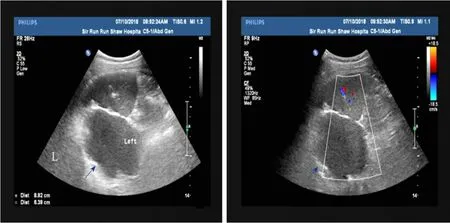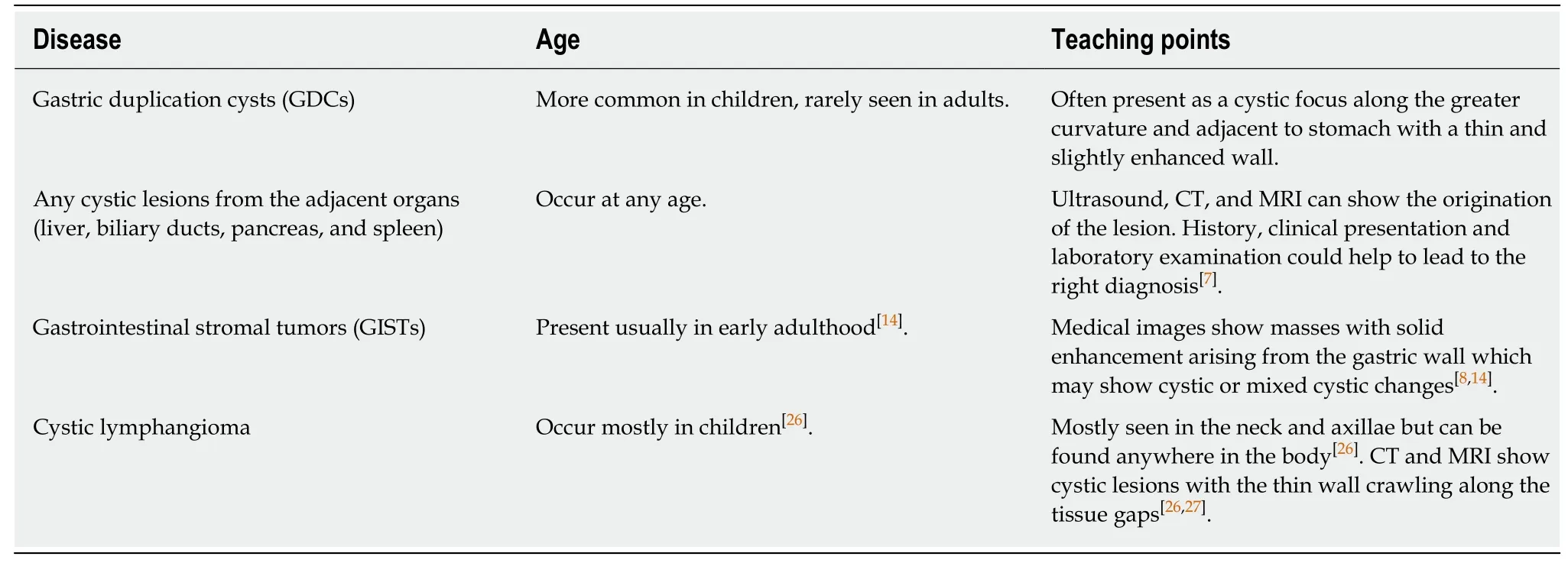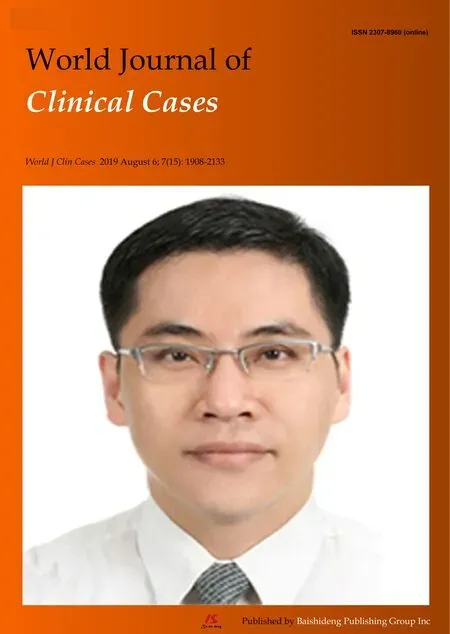Gastric duplication cyst mimicking large cystic lymphangioma in an adult: A rare case report and review of the literature
2019-08-14FangYiXvAlexSunYiGanHongJieHu
Fang-Yi Xv,Alex Sun,Yi Gan,Hong-Jie Hu
Abstract
Key words: Gastrointestinal abnormality; Gastric duplication cyst; Computed tomography;Ultrasound; Magnetic resonance imaging; Case report
INTRODUCTION
Gastrointestinal tract duplications are a rare congenital developmental malformation most frequently seen in infants with an incidence of about 1 in 4500 live births and a sex ratio of approximately 2 to 1 (female to male)[1,2].A gastrointestinal tract duplication is defined as a tubular or spherical structure sharing a common muscular wall and blood supply with normal gastrointestinal tract but having a separate mucosal lining[3],which can appear anywhere along the gastrointestinal tract from the mouth to the anus,with the ileum being the most common location[1,4,5].Gastric duplication cysts (GDCs),accounting for about less than 10% of gastrointestinal tract duplications,are rarely seen in adults as most cases are diagnosed in childhood,and over 70% cases are discovered before the age of 12[1,4,6].Although GDCs in adult are a rare entity,they may present with various symptoms including abdominal pain,gastric outlet obstruction,or a palpable abdominal mass.
CASE PRESENTATION
Chief complaints
A 51-year-old man was admitted to our hospital because of a two-year history of repeated episodes of epigastric pain and fullness without any obvious causes.
History of present illness
Two years ago,the patient began to present recurrent upper abdominal pain.The recurrent episodes of pain lasted approximately 1 h and were associated with nausea.
History of past illness
The patient denied any past surgical interventions.
Physical examination
Initial evaluation in the hospital showed no remarkable clinical examination findings.
Laboratory examinations
Laboratory test results were within normal limits.
Imaging examinations
An abdominal ultrasound showed a large cystic lesion in the upper left quadrant abdomen,which was initially thought to be retroperitoneal (Figure 1A).No significant vascular flow was seen on Doppler (Figure 1B).
A contrast-enhanced abdominal computed tomography (CT) scan was performed for further evaluation (Figure 2).The scan showed a large cystic hypodense lesion,measuring 95 mm × 61 mm × 66 mm,between the spleen and stomach,which was anterior to the left renal fascia and in close proximity to lateral limb of the left adrenal gland.The lesion was lobulated and well-circumscribed with a small amount of wall calcification.
Primary diagnosis
A cystic lymphangioma was the primary diagnostic consideration prior to pathological confirmation according to the imaging examination.
MULTIDISCIPLINARY EXPERT CONSULTATION
Guan-Yu Wang,MD,Chief Doctor,Department of General Surgery,Zhejiang University School of Medicine
Considering recurrent abdominal pain and the imaging findings of an abdominal mass,the patient needed to take surgical treatment into consideration for symptomatic relief.
TREATMENT
The patient chose surgical intervention for symptomatic relief.During the surgery,it was noted that the lesion was adherent to the greater curvature of the proximal stomach,between the superoposterior aspect of the pancreas and splenic hilum.A laparoscopic resection of the perigastric mass and partial gastrectomy were performed.
FINAL DIAGNOSIS
Histological sections showed gastric mucosa-like tissues within the cyst wall and a diagnosis of GDC was made for the patient (Figure 3).
OUTCOME AND FOLLOW-UP
The patient recovered quickly after the surgery without any postoperative complications.There were no recurrent symptoms during his 8-month outpatient follow-up.
DISCUSSION
GDCs are a class of gastrointestinal tract duplications,most commonly occurring in children and very rarely in adults.GDCs have no specific clinical symptoms in adults and the symptoms mainly depend on the lesion location,size,and whether any communication exists with the gastric lumen.Clinical symptoms include nausea,vomiting,abdominal pain,palpable abdominal mass,gastrointestinal bleeding (from ulceration related to ectopic gastric mucosal acid secretion),weight loss,anemia,and failure to thrive[1,6-10].Some cases are asymptomatic and only incidentally detected during physical examination[7](Table 1).GDCs can produce all the pathological changes that may occur in the normal gastric lining,including gastritis,gastric ulcer,and even malignant transformation[11,12].To date,less than 15 cases of malignant transformation arising from GDCs have been reported[7,12-14].In rare cases,GDCs have been reported to contain ectopic pancreatic tissue[15,16].Pancreatitis can occur in these cases if the ectopic pancreatic duct is obstructed[16,17].Laboratory tests in GDCs tend to be unremarkable.Rarely,some cases have abnormally elevated carcinoembryonic antigen (CEA) and CA 19-9[18,19].These cases may be associated with malignant transformation of GDCs.

Figure 1 Ultrasound images of the gastric duplication cyst.
GDCs tend to be found along the greater curvature of the stomach[1,4].It can be divided into intraluminal and extraluminal types according to the location;communicating and non-communicating types according to its connection with gastric lumen; and complete and incomplete duplication according to the degree of deformity.The extraluminal and non-communicating types are more common compared with the intraluminal and non-communicating types,accounting for more than 80% of reported cases[1,4,7].Complete communicating GDCs are really rare.There has been only one reported case in the past 17 years[1].
The mechanism of GDCs is still unclear but several theories have been proposed to explain the formation of gastrointestinal duplications.Some scholars theorize that gastrointestinal duplications share a similar mechanism with that of diverticulum formations and some believe they are caused by the abnormal development of early embryonic primitive foregut formation and differentiation[1,2,7].
On conventional radiography,intraluminal contrast agent filling can be seen in the communicating type GDCs.In contrast,non-communicating type GDCs would only show gastric wall indentation,indicating a submucous or extraluminal lesion.
CT and magnetic resonance imaging (MRI) are valuable for determining the size,location,and extent of the duplication cyst as well as the relationship to adjacent structures[1,20].GDCs may be round or lobulated with a thin wall on cross-sectional images[7].When the duplication cyst is very large and in close proximity to adjacent organs such as the spleen,kidney,or liver,it may be misdiagnosed as a cyst arising from these organs.MRI has high soft tissue resolution and signal changes in multiple phases may present the thin cyst wall usually with slight enhancement,which is useful for distinguishing the origin of the cyst[6].In our case,no enhanced cystic wall was observed by enhanced CT,but a nutrient vessel arising from the stomach was seen in the cyst wall,which was a helpful imaging feature to identify the origin of the cystic lesion.GDCs occasionally present calcification within the cyst wall,which may be related to the accumulation of secretion or necrosis.Multiple calcifications in the cyst wall were observed in our case and the case reported by D'Journoet al[21].Awanet al[22]introduced a special case with multiple calcifications mimicking a staghorn calculus.The contents of most GDCs present fluid density/signal,but bleeding or infection may result in the heterogeneity of density/signal,which can make diagnosis of GDCs in adults complicated[4].GDCs also need to be distinguished from gastrointestinal stromal tumors (GISTs).GISTs are solid tumors originating from the submucous mesenchymal tissue of the gastrointestinal wall,and vary greatly in size with hemorrhage and necrosis occurring in large tumors and mild or moderate enhancement involving the solid portions of GISTs.
Ultrasound is a noninvasive method widely used for screening in patients with abdominal symptoms.In most cases,ultrasound shows a hypoechoic cystic lesion in the upper abdomen,often adjacent to the stomach,pancreas,and liver.
Endoscopic ultrasound (EUS) is considered a good diagnostic tool for the detection of GDCs because it can show the internal hyperechoic mucosal layer and the hypoechoic smooth muscle layer of the cyst[21].In recent years,EUS-guided fineneedle aspiration (EUS-FNA) plays an important role in clinical diagnosis of GDCs[5].
On pathology,a GDC must have both a smooth muscle layer and a mucosal epithelial layer (gastrointestinal,gastric,or respiratory mucosa) in the cyst wall[7,14].Our case had all the layers meeting the diagnostic requirements.

Figure 2 Contrast-enhanced computed tomography images of the gastric duplication cyst.
Up to now,there are no well-recognized international guidelines on the treatment of this disease.Several treatment methods have been reported in the literature,including enucleation,formation of cystogastrostomy,and even endoscopic removal[3].Surgical excision is usually considered the mainstay of treatment for GDCs.Surgical resection is performed not only for the consideration of symptomatic relief and the prevention of potential complications caused by GDCs such as obstruction,torsion,perforation,bleeding,but also for the risk of malignant transformation in GDCs[3,7].We performed a review of the English papers about GDCs in the past 17 years on PubMed and found that the majority of those cases had a good prognosis with complete symptomatic relief after surgical resection while only a few cases with malignant transformation developed recurrence or metastasis[11,12,14,23-25].
CONCLUSION
GDCs are a quite rare malformation in adults usually with non-specific clinical symptoms.Some imaging modalities including ultrasound,CT,and MRI are able to figure out morphological features for GDCs diagnosis and EUS could present the exact micro-structure of the cystic wall.We deem that GDCs should be put in the differential list for a cystic mass adjacent to gastric lumen.

Table 1 Teaching points for differential diagnosis

Figure 3 Photomicrograph (hematoxylin and eosin staining,original magnification,×4) of the surgical specimen demonstrates an inner mucosal layer(arrows) within the cystic mass,along with a continuous muscular layer (asterisk) shared with the stomach.
杂志排行
World Journal of Clinical Cases的其它文章
- Percutaneous coronary intervention for ostial lesions of the left main stem in a patient with congenital single left coronary artery: A case report
- Common iliac artery occlusion with small intestinal transection caused by blunt abdominal trauma: A case report and review of the literature
- c.753_754delAG,a novel CFTR mutation found in a Chinese patient with cystic fibrosis: A case report and review of the literature
- Fever and neck pain after pacemaker lead extraction: A case report
- Endometriosis of the duplex appendix: A case report and review of the literature
- Oncogenic osteomalacia caused by a phosphaturic mesenchymal tumor of the femur: A case report
